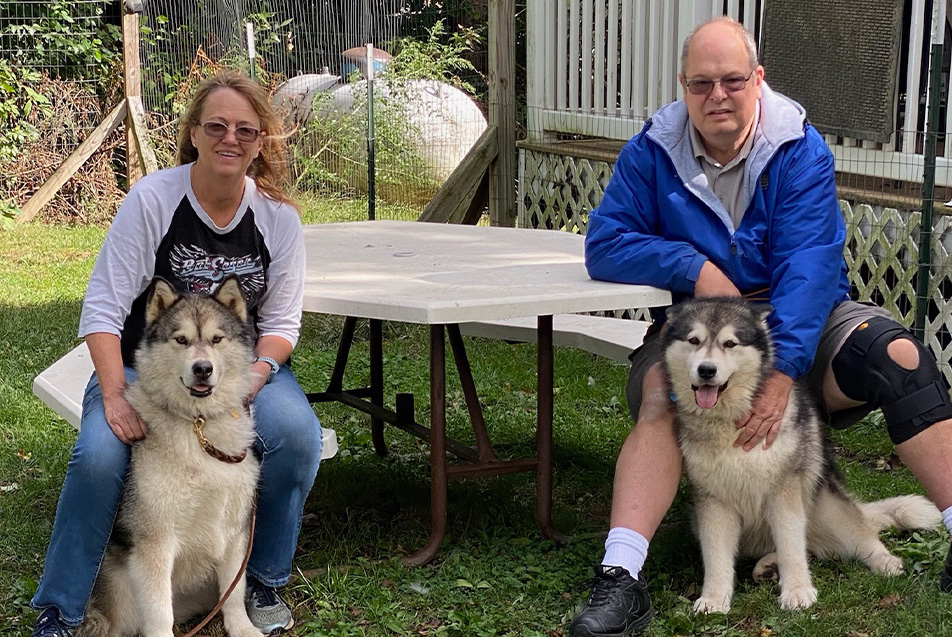
Individuals coping with a severe illness or nearing the end of life often experience waves of emotional and physical symptoms. Fortunately, hospice care can provide support to ease these discomforts and promote healing. Parkview’s Hospice Volunteer program frequently utilizes pet therapy as one facet of this process and their volunteer services. So, to learn more, we invited Wilma "Gail" Williams and Jessica Sellers, hospice volunteer coordinators, Parkview Hospice, to share more about this exceptional program and the difference made by one volunteer in particular.
The volunteer program
The Parkview Hospice Volunteer program provides a variety of services to our hospice patients based on their interests and required level of care. A volunteer coordinator works with each patient, their care team and family members to determine the type of volunteer that would meet their requirements, from companionship and caregiver relief to pet therapy and more. Then, a coordinator will pair the patient with the volunteer that best fits those needs.
Sean Dreer and his wife, Belva Sutton, are perfect examples. They provide pet therapy, also known as animal-assisted therapy, to Parkview Hospice patients. For the past six years, they and their four-legged family members have continued to visit hospice patients in area hospitals, nursing facilities and patients’ homes. Tori and Casey, female Alaskan Malamutes, are specially trained as therapy pets and members of Paws, Inc. here in Fort Wayne and part of the Alliance of Therapy Dogs.
How it works
In most cases, Sean and his pack coordinate their visits and any requests through the hospice volunteer coordinator. If the date works for Sean’s schedule, then they begin preparations for the visit. Everything from getting ready to the visit itself is a treat for the pups.
“It starts with a spa day, where the dogs are bathed and brushed to remove as much loose hair as possible,” said Sean. “Then, once we arrive at our destination, the fun can begin.”
A typical visit can last anywhere from 15 minutes to two hours, depending on the patient and their preferences. Most people enjoy petting the dogs, talking to them and giving them treats.
“Depending on the person, they may already have dog treats because they know the dogs are coming for a visit,” said Sean. “But I always bring some, too, for those who may not have them because everyone wants to give the dogs treats. The dogs love it, and so do the people we visit.”
And, since Sean’s dogs have so many fans, if he takes them into a group setting such as a nursing facility or hospital, he often checks to see if anyone else nearby would like to visit, and more often than not, they do.

Benefits of pet therapy
Pet therapy is known to help reduce loneliness, anxiety, stress, and so much more. Given the population that we are serving, all these things can be extremely important for patients. Allowing therapy pets to come in and visit can provide both physical and emotional benefits to both the patients and their families.
Moreover, studies have shown that pet therapy provides many benefits. One study revealed that individuals with dementia engaged in more frequent and extended social interactions with those around them following a pet therapy visit. [1] Other studies have indicated that visits with trained therapy animals can lower blood pressure and levels of stress hormones.
Why volunteering matters
Having a volunteer can be extremely beneficial to a patient and their caregivers. For example, if a patient doesn’t have much family or anyone to visit, a volunteer can provide that support, comfort and peace in a time where they may feel very isolated or alone.
As for the volunteer, there are several reasons why serving in a hospice role benefits that individual. It may bring a sense of meaning for some, knowing they are making a difference in someone else’s life. For others, it may feel like a calling to help others. And volunteering in a hospice setting can bring them a sense of fulfillment.
When asked what he loved most about volunteering with the hospice program, Sean had this to say, “We love giving back to the community and seeing the smiles on people's faces, especially during a difficult time in their life,” Sean stated. “It's so satisfying to make somebody else happy, especially right now with the pandemic. Not to mention, our dogs love it!”
Final thoughts
There are so many reasons why volunteering is important, and it takes a special person to take on the role. “Volunteers like Sean go above and beyond their assigned role, illustrating the type of people we bring to the hospice volunteer program and why it is so great. Our program is fortunate to have some truly unique people for whom we are incredibly thankful,” Jessica said.
Parkview is accepting applications for individuals 18 years of age or older. Interested individuals can apply for hospice volunteer opportunities here.
Sources
[1] Nancy E. Richeson, PhD, CTRS American Journal of Alzheimer’s Disease and Other Dementias.



